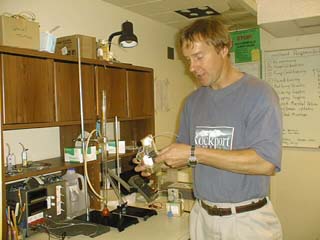4 August, 1998
Tuesday, August 4th, 1998
It is still raining in Boulder. I am learning the lab techniques
for the ozonesonde-preparations. Bryan Johnson, the research scientist
from the Ozone and Water Vapor Group with whom I will be working with
most of the time, explained some of the general procedures to me and I
am glad that some of these I will see and hear over again. It is a lot
to remember. I will be more detailed about it later when I am more
familiar with: ozonesonde, solutions, radio sonde, computer programs,
ozone calibration.... .
Bryan has been with the ozone and water vapor group for the past
four years. He received his Undergraduate degree in Chemical
Engineering from the Montana State University, his Masters in Mineralogy
from the South Dakota School of Mines and Technology in Rapid City, S.D,
and his PhD in Atmospheric Science from the University of Arizona. He
is responsible for analyzing data, monitoring and supplying seven sites
that launch one ozonesonde per week at times several times per week.
These sites are:
1. South Pole
2. Hilo Hawaii
3. American Samoa
4. Trinidad, California
5. Tahiti
6. Fiji and
7. Boulder
It is a very busy group with a lot of details to coordinate. Bryan has
been spending a lot of time with me discussing ozone and depletion as
well as discussing the difference in ozone distribution at the different
launching sites.
If you want to know more about the ozone group, you can check out the
web site: http://www.cmdl.noaa.gov/ozsondes/
The picture below shows Bryan Johnson removing the top of an ozonesonde
while he was teaching us the lab procedure.
I also read up on some general ozone information and I will introduce
SOME FACTS ABOUT THE ATMOSPHERE .
(From " The Changing Ozone Layer", By Rumen D. Bojkov: A joint
publication of the World Meteorological Organization and the United
Nations Environment Programme.
http://www.cmdl.noaa.gov/dobson/wmobro/main.html#TOC )
Our Atmosphere and the Rare Ozone Molecule
99 % of the air we breathe is nitrogen (78%) and oxygen (21%).
This ratio has not changed in millions of years. The remaining 1% are
made up of rare components such as water vapor, carbon dioxide, methane,
nitrous oxide, ozone and inert gases (e.g. argon, helium, neon). In
every ten million air molecules on average only three are ozone. If all
the ozone in the atmosphere was transferred to the Earth's surface, it
would combine to a thickness of only about 3mm !! This is truly a rare
molecule! and yet, it plays a vital role in the life of our planet.
Ozone absorbs harmful solar ultraviolet radiation (below about 320 nm)
and shields us and all other living things from damage. The ozone layer
has the right thickness to have the visible light penetrate to the
surface of the earth which is the reason for life on earth. We ought to
be thankful!!
Although a rare molecule, the total ozone in the atmospheric
column at a parcticular place varies and is determined by large-scale
atmospheric dynamics. For instance, ozone is mostly produced near the
equator . The ozone layer there is more constant than anywhere else in
the world. Circulation of air masses distributes the ozone molecules to
other parts in the world. The atmospheric dynamics is also responsible
for the distribution of other parcticles such as pollutants or parcticles
such as aerosol created during a volcanic eruption. ( More about the
influence of volcanic eruption on the ozone depletion in the Antarctic
later.) In other words, a pollutant created in the North might end up
in the South or even over the Antarctic.
The Ozone Layer
Starting from the surface of the earth, our atmosphere can be
divided into several layers: the troposphere (< 18 km), Stratosphere (~
km), and Mesosphere (> 55km). About 90% of the atmospheric ozone is
located in the stratosphere where it reaches its highest concentration
between about 19 and 23 km above the surface of the earth. The air
temperature decreases rapidly with height in the troposphere and
increases in the stratosphere because ozone absorbs radiation. The
tropopause is the transition between the troposphere and stratosphere
and it is usually indicated by the sharp increase of temperature.
What is Ozone?
Ozone (O3) is a form of the element oxygen ( O ) which has three
atoms in each molecule instead of the two of normal oxygen molecules
(O2). It is formed in the stratosphere by the action of solar radiation
(UV, ultraviolet radiation) on the oxygen molecule. The process is
called photolysis = light parcticles, photons are being lysed, broken up;
the gained energy helps to break down the oxygen.. An oxygen molecule
(O2) is broken down into atomic oxygen which can combine with molecular
oxygen to produce ozone.
Ozone is destroyed naturally trough a series of catalytic cycles
involving oxygen, nitrogen, chlorine, bromine and hydrogen. Such
chemicals were all present in the stratosphere long before humans began
polluting the air. Nitrogen compounds come from soils and the oceans,
hydrogen comes mainly from atmospheric water vapor and chlorine comes
from the oceans in the form of methyl chloride and methyl bromide.
For detailed text and information link to the following web site page:
http://www.cmdl.noaa.gov/dobson/wmobro/intro.html

The picture shows Bryan Johnson from the CMDL Ozone and Water Vapor group. He is removing the top of the ozonesonde-cells while he explains how the sonde needs to be prepared.
Contact the TEA in the field at
.
If you cannot connect through your browser, copy the
TEA's e-mail address in the "To:" line of
your favorite e-mail package.
|
